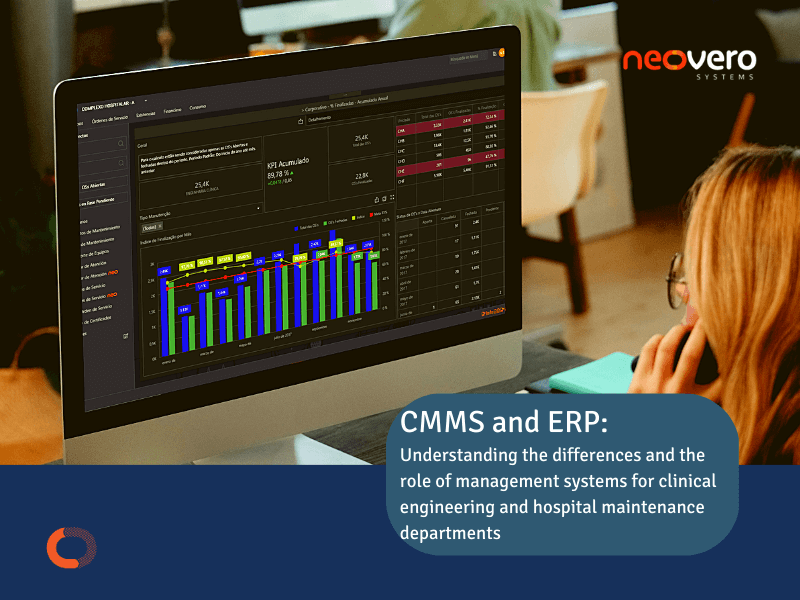
Computerized systems is already a reality in Health Care establishments, helping and optimizing the chain of processes related to the institutions’ equipment. Among the most used software, we must highlight CMMS(Computerized Maintenance Management System) for the management of maintenance and its equipment, and ERP (Enterprise Resource Planning) for the integrated management of the activities within the organization. Despite having clearly differentiated scopes, it is common to confuse both types of systems and believe that with some functionalities present in ERP, specific processes of the Clinical Engineering and Hospital Maintenance departments can still be addressed.
There are some similarities between CMMS and ERP, however the differences in the managed processes of both software are much greater, mainly from the point of view of the specific managerial and operational needs from the maintenance departments, as well as the internal customer or end user for which it was developed.
ERP – Enterprise Resource Planning
Enterprise Resource Planning (ERP) is an integrated business management software that allows you to centralize the activities of different sectors of an organization such as small, medium or large. It offers a method to finance, inventory, purchasing, human resources, project management, tax, procurement, etc., through modules. In the hospital environment, an ERP includes management processes related to patient care, such as electronic medical records and history to support clinical decision-making, bed management and scheduling, as well as integration with LIS (Laboratory Information System), RIS (Radiology Information System), and PACS (Picture Archive and Communication System) assisting in the management of data and information in a centralized platform.
According to the organization needs and specificities, a system for maintenance and equipment management can be implemented. However, the information contained in this system is usually very complex when considering the maintenance departments and their needs for technical control and patient safety, as it is not a system developed specifically for this purpose.
CMMS – Computerized Maintenance Management System
A CMMS is a Computerized Maintenance Management System, such as Neovero. One of the strengths of a CMMS is that it can monitor all the processes involved in maintenance management and traceability.
A CMMS can register and control all the equipment of an organization, manage a service order from the entry process of a repair order with details of the entire history of the service provided, and generate detailed reports on the operation further automating preventive service orders and managing inventory parts that are used to conduct maintenance.
In addition to the available web-based software, the mobile version of the CMMS allows users to update and record service information in real time, keeping the organization’s database safe with reliable information. With the recorded information, maintenance department managers can create indicators based on department specific KPI’s such as OS completion rate, pending work order assessment, equipment replacement value, maintenance costs, and many others.
CMMS and ERP are not considered competing systems, nor do they serve the same management processes, since a CMMS operates at points that are not the focus of an ERP, and vice versa, specifically for maintenance management. Usually, a CMMS tends to have a lower implementation and operation cost when compared to an ERP. In addition to cost, we can highlight some advantages of a CMMS over an ERP at the heart of activities in the sectors of clinical engineering and hospital maintenance:
- Predictive and preventive maintenance planning with labor and materials forecast
- Management of services, projects, and contracts with suppliers
- Productivity control of the technical team
- Equipment performance management
- Metrological management, with calibration reports from data and information required by industry standards
- Metrics and indicators of equipment availability; time between failures, repair time, etc.
- Business Analytics / Business Intelligence tools for decision making in order to maximize the useful life of equipment
Finally, it is possible to
Integrating the solutions will make it possible to take advantage of the full potential of the systems. With integrated systems, a part purchase request made within a service order in the CMMS will be reflected in the ERP purchasing module. A service request opened in the ERP will be managed by the CMMS. To meet these demands, today Neovero makes available to its customers interested in the integration process our REST API.
The proper use of technologies available on the market tends to play an important role in the treatment provided to the patient, benefiting and ensuring assertiveness and safety in the care provided. For this, it is important to understand the function of each software, aiming to optimize its use within an institution, whether using each tool separately or through an integration where both interact automatically.
